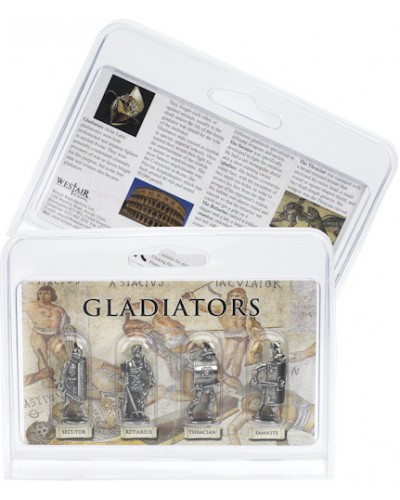Product Description: This set of 4 Roman Gladiator figures, each measuring 4cm tall, are made from lead-free pewter. The four different gladiators in the pack are Secutor, Retiarius, Thracian and Samnite. The supplied information card is full colour with an image from a Roman mosaic depicting gladiators on the front and has historical information on the reverse, together with additional images. The figures and card are held in a clear clam-shell pack.
Information: Gladiators (from Latin gladiatores) were both professional and amateur fighters in ancient Rome. They were generally condemned criminals, prisoners of war or slaves bought for this purpose, but some free men and women also became gladiators. They fought each other, or against animals, usually to the death unless the life of the losing gladiator was spared by the vote of the audience.
Gladiators were trained in combat in special, imperial schools. Once trained they would then fight for the entertainment of the crowds in arenas or amphitheatres. The most famous amphitheatre was the Colosseum in Rome (the Flavian Amphitheatre) which was built around 80 AD and seated 50,000 people.
Different gladiators specialised in different weapons and tactics.
The Secutor was specifically developed to fight the retiarius. He had a tall rectangular shield and a short stabbing sword (gladius). His helmet covered his entire face, with the exception of two small eye-holes, in order to protect his face from the thin prongs of his opponent’s trident. His helmet was almost round and smooth so that the retiarius’ net could not get a grip of it.
The Retiarius carried a trident, a dagger and a net, a large armguard (manica) extended to the shoulder and left side of the chest. They commonly fought secutores or mirmillones. Occasionally a metal shoulder shield (galerus) was added to protect the neck and lower face.
The Thracian was equipped with a broad-rimmed helmet that enclosed the entire head, a small round or square-shaped shield, and two thigh-length greaves. His weapon was the Thracian curved sword (sica). They commonly fought mirmillones or hoplomachi.
The Samnite used a large oblong shield (scutum) and wore a metal or boiled leather greave (ocrea) on his left leg. He also wore a visored helmet (galea) with a large crest and plume and was armed with a sword (gladius).

